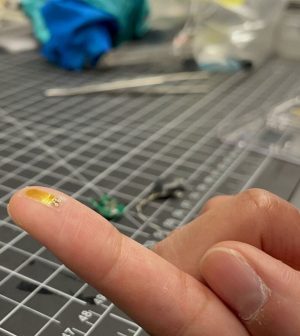- USDA Gets Tougher on Salmonella in Raw Breaded Chicken Products
- Fragments of Bird Flu Virus Found in 1 in 5 Milk Samples
- Clients Got HIV Through ‘Vampire Facial’ Microneedling Treatments
- Take the Stairs & Step Up to Longer Life
- ‘Drug Take Back Day’ is Saturday: Check for Leftover Opioids in Your Home
- Loneliness Can Shorten Lives of Cancer Survivors
- A Stolen Dog Feels Like Losing a Child, Study Finds
- Healthier Hearts in Middle Age Help Black Women’s Brains Stay Strong
- Better Scans Spot Hidden Inflammation in MS Patients
- Which Patients and Surgeries Are ‘High Risk’ for Seniors?
Implant Can Warn Weeks Early That Transplanted Organ Will Be Rejected

Receiving an organ transplant can be a nerve-wracking, if lifesaving, affair, said Dr. Joaquin Brieva, a kidney transplant recipient.
“Within two days of my transplant, my kidney function was back to normal, but then you worry about the possibility of kidney rejection,” said Brieva, a dermatologist at Northwestern Medicine in Evanston, Ill., who got his transplant in September 2022.
“You’re walking a tightrope of anxiety about infections, complications from the drugs, various side effects and rejection of the kidney,” Brieva said in a Northwestern news release. “You can manage some of that concern with medication adjustments, but kidney rejection remains prevalent. Your transplanted kidney is extremely precious, so that was my biggest concern.”
An experimental implant now in testing could one day help organ recipients find some peace of mind, researchers say.
The tiny, paper-thin implant appears to provide early, accurate, real-time warning of organ rejection, according to a new study.
The ultrathin soft implant sits directly on a transplanted kidney, and can detect temperature changes that can occur with transplant rejection, researchers reported Sept. 7 in the journal Science.
The device then sends a wireless alert to a nearby smartphone or tablet, warning that something might be going wrong.
Researchers tested the device in small animals with transplanted kidneys.
The device wound up detecting warning signs of rejection up to three weeks earlier than current monitoring methods, researchers said.
This extra time could enable physicians to intervene sooner, reducing the risk of organ rejection.
“If rejection is detected early, physicians can deliver anti-rejection therapies to improve the patient’s health and prevent them from losing the donated organ,” said device development lead John Rogers, a professor of biomedical engineering at Northwestern University.
“In worst-case scenarios, if rejection is ignored, it could be life-threatening,” Rogers said in the release. “The earlier you can catch rejection and engage therapies, the better. We developed this device with that in mind.”
For the more than 250,000 people in the United States living with a transplanted kidney, monitoring their organ’s health is an ongoing journey, researchers said in background notes.
Rejection can occur at any time after a person receives a transplant, either immediately after or years down the road, researchers noted. It is often silent, and patients might not experience symptoms.
“I have noticed many of my patients feel constant anxiety — not knowing if their body is rejecting their transplanted organ or not,” said clinical lead researcher Dr. Lorenzo Gallon, a Northwestern Medicine transplant nephrologist.
“They may have waited years for a transplant and then finally received one from a loved one or deceased donor. Then, they spend the rest of their lives worrying about the health of that organ,” Gallon said in the release. “Our new device could offer some protection, and continuous monitoring could provide reassurance and peace of mind.”
The easiest way to monitor kidney health is through blood tests, but the standard biomarkers can fluctuate for reasons unrelated to organ rejection, researchers said.
The current “gold standard” for detecting rejection is a biopsy, with a physician using a long needle to extract a tissue sample from the transplanted organ.
But this invasive procedure risks multiple complications, including bleeding, infection, pain and even inadvertent damage to nearby tissues.
On top of that, having a lab analyze biopsy results can take time the patient might not have.
“The turnaround time can be quite long, and they are limited in monitoring frequencies and require off-site analysis,” Gallon said. “It might take four or five days to get results back. And those four or five days could be crucial in making a timely decision for the care of the patient.”
Northwestern’s research team designed its new bioelectronic implant to monitor something much simpler and more reliable — the organ’s temperature.
Temperature increases typically accompany inflammation. Given that, researchers figured that sensing out-of-the-ordinary temperature increases and variations might provide an early warning sign for potential transplant rejection.
The animal study confirmed their suspicion, with researchers finding that the local temperature of a transplanted kidney increases just before rejection events.
In animals without immunosuppressant medications, temperatures increased two or three days before biomarkers changed in blood tests.
And in animals taking immunosuppressant medications, the temperature not only increased but also displayed additional variations as much as three weeks before biomarkers increased.
The new device also offers continuous, real-time monitoring, rather than current methods.
Patients might get blood tests more than once per week right after receiving their transplant, but over time the tests become less frequent.
“Having this device would be reassuring,” said Brieva, who was not involved with the study. “It can pick up any sudden changes in the kidney transplant and detect acute rejection, which currently gives no warning signs.”
The sensor itself is tiny, smaller than a pinky fingernail and about the width of a single hair.
Rogers and his team designed the sensor to fit just below a fibrous layer called the renal capsule that covers the kidney and protects the organ from damage. There, it rests snugly against the kidney.
“The capsule keeps the device in good thermal contact with the underlying kidney,” Rogers said. “Bodies move, so there is a lot of motion to deal with. Even the kidney itself moves. And it’s soft tissue without good anchor points for sutures. These were daunting engineering challenges, but this device is a gentle, seamless interface that avoids risking damage to the organ.”
The device contains a highly sensitive thermometer that can detect incredibly slight temperature variations on the kidney. It is connected to a tiny package of electronics, including a miniature coin cell battery for power, which sits next to the kidney and uses Bluetooth technology to stream data continuously and wirelessly.
“We imagine that a surgeon could implant the device immediately following the transplant surgery, while the patient is still in the operating room,” Rogers said. “Then, it can monitor the kidney without requiring additional procedures.”
The researchers are now testing the system in a larger animal model, and are evaluating ways to recharge the coin cell battery so that it can last a lifetime.
While these first studies focused on kidney transplants, the researchers assume it could also work for other organ transplants, including the liver and lungs.
“Each individual responds to anti-rejection therapy differently,” said lead researcher Surabhi Madhvapathy, a postdoctoral researcher in Rogers’ laboratory. “Real-time monitoring of the health of the patient’s transplanted organ is a critical step toward personalized dosing and medicine.”
More information
The Cleveland Clinic has more about organ transplant rejection.
SOURCE: Northwestern University, news release, Sept. 7, 2023
Source: HealthDay
Copyright © 2024 HealthDay. All rights reserved.









